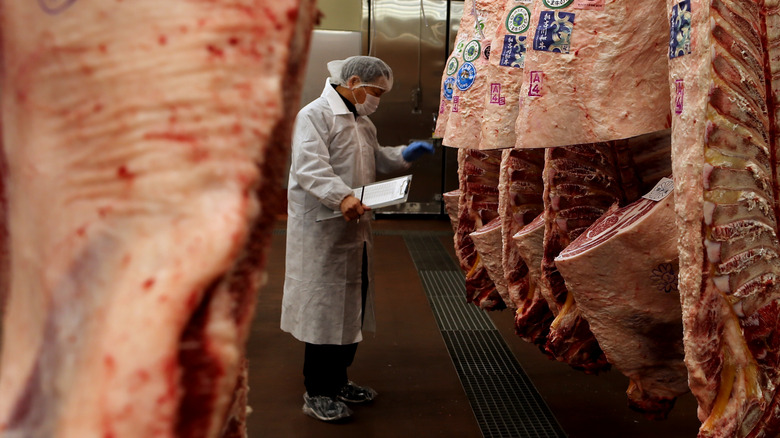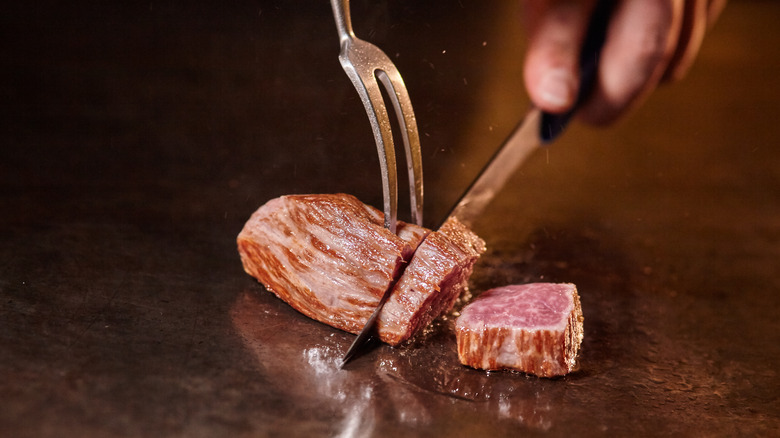If you’ve ever been to a fancy steakhouse and seen Wagyu steak or, more likely, Wagyu sliders on the menu, your meal was probably one of the most expensive ones there. Wagyu beef is known for being the most expensive steak you’ll ever eat. Insider says that Grade A certified Wagyu raised in Japan can fetch more than $200 a pound, and the cows that produce them are worth $30,000 each, which is 40 times the price of a normal cow sold in the U.S. S.
Because Wagyu beef is so rare, it might look like Japan is the only country that sells it. However, the price you’re paying isn’t just an extra charge; it turns out that a lot of work goes into making Wagyu beef, which isn’t like the other meats you can buy at the store.
With its sky-high price tag, is Wagyu beef really worth buying? This exceptionally marbled and decadent style of Japanese beef commands a premium price that can seem staggering compared to conventional steaks. But devotees insist the melt-in-your-mouth tenderness, rich flavor, and luxurious fat content make Wagyu an incredible treat for special occasions. Read on to learn what makes this beef so special and whether it’s worth splurging on.
What Exactly is Wagyu Beef?
Wagyu refers to four specific Japanese cattle breeds – Japanese Black, Japanese Brown, Japanese Shorthorn, and Japanese Polled. “Wa” means Japanese and “gyu” means cow in Japanese
True Wagyu beef comes from purebred Wagyu cattle raised in Japan. However, the term is also used internationally for cattle crossbred with Wagyu genetics.
No matter its origin, Wagyu is prized for its extensive marbling. The fat is finely dispersed throughout the meat instead of in larger chunks. This contributes to the distinctive texture and taste.
The History and Advantages of Wagyu Cattle
In Japan, Wagyu cattle have been bred for superior marbling over centuries Special pampering like massages and beer developed the generous marbling. The breeds even have genetic mutations that increase intra-muscular fat
Wagyu fat has a lower melting point than other beef, making it melt at room temperature This gives an incredibly tender, velvety texture The fat also imparts a sublime buttery, nutty richness.
The ample marbling makes the beef exceptionally juicy and flavorful. Even with little aging, it develops sophisticated umami depth.
Why Wagyu Beef Costs More
Several factors contribute to the steep price tag on Wagyu beef:
-
Specialized breeding – Centuries of focused breeding make Wagyu genetically predisposed to generous fat marbling.
-
Limited supply – Only cattle raised in Japan can be called authentic Wagyu, constricting global supply.
-
Intensive raising methods – Authentic Wagyu cattle are pampered with massages and beer for perfect fat distribution.
-
Greater land needed – Wagyu cattle take longer to raise due to their genetics, requiring more land.
-
Expert butchering – Complex marbling patterns require exceptional skill to cut into steaks.
-
Low yield – The high fat ratio means less usable lean beef per carcass. More is needed to produce steaks.
Simply put, real Japanese Wagyu costs more because it takes more time, land, breeding, and skill to produce beef with that level of marbling.
Price Differences by Grade
Wagyu beef is graded on a scale from A1 to A5 based on marbling. A5 is the top grade, with the most extensive, beautiful fat marbling. Here’s how the grades compare:
-
A1 – Minimal marbling. More affordable but lacks Wagyu richness.
-
A2 – Modest marbling like USDA Prime beef. A noticeable step up from A1.
-
A3 – Moderate marbling with more fat veins between muscle fibers. Very good quality.
-
A4 – Abundant marbling creates a rich texture. Considered a premium luxury.
-
A5 – Highest grade with extensive, exquisite marbling. The pinnacle of Wagyu indulgence.
A5 Wagyu can cost $200+ per pound, while A1 is closer to $40 per pound. For the true, melt-in-your-mouth Wagyu experience, A4 and A5 grades are best.
Is Wagyu Worth the Price Tag?
At over $100+ per pound, Wagyu undoubtedly represents a splurge. However, foodies argue that no other beef compares in delivering a transcendent, almost spiritual eating experience. Advocates say the joy of tasting true top-quality Wagyu is priceless.
Wagyu isn’t necessarily meant for everyday meals. It excels as a rare, special treat for memorable dinners and celebrations. Even hardcore meat enthusiasts view it as a bucket list food.
Trying a small amount of expertly prepared Wagyu can offer a glimpse into this unique and refined style of beef. Just a few thin slices can provide a fully indulgent encounter.
How to Make the Most of Your Wagyu Experience
To make the most of the steep investment, follow these tips when buying and eating Wagyu beef:
-
Stick to A4 or A5 graded Japanese Wagyu for the ultimate experience. Lower grades don’t deliver the same impact.
-
Look for deep red meat with a fine marbling pattern like snowflakes or spiderwebs. Avoid any dark or dull spots.
-
Buy thicker cuts like ribeye or strip steak to appreciate the explosive tenderness within.
-
Cook Wagyu minimally to medium-rare at most. High heat ruins the delicate fat and texture.
-
Savor each bite slowly. Let the complex flavors unfold across your palate.
-
Pair with a quality red wine that won’t overpower the beef. Or enjoy it solo.
-
Share Wagyu with other serious foodies who will appreciate this incredible indulgence.
While not an everyday steak, Wagyu can provide a supremely special and memorable beef experience for those moments when only the very best will do. The splurge is undoubtedly worth it for hardcore carnivores.
Wagyu Alternatives for Any Budget
Of course, not everyone can afford authentic Japanese Wagyu. Here are some ways to enjoy the Wagyu experience at other price points:
-
American Wagyu – Domestic cattle crossbred with Wagyu genetics for marbling. Less expensive but still a treat.
-
Wagyu burgers – Blend of Wagyu trimmings for a more affordable taste. Excellent gateway option.
-
Wagyu carpaccio – Paper-thin raw slices let a little Wagyu go a long way. Showcases the rich flavor.
-
A5 steak flight – Order a shared tasting of different A5 Wagyu cuts at a steakhouse.
-
Wagyu fat add-ons – Add strips of buttery Wagyu fat to other cuts like ribeye to amp up flavor.
With the right strategy, you can still enjoy the decadence of Wagyu beef even on a budget. It’s absolutely worth trying at least once in your life if you love great steak.

Here’s what you’re paying for

Although the word Wagyu literally translates to “Japanese cow” in Japanese (via The Meatery), not all Japanese cows can be considered Wagyu. Eat This, Not That explains that farm-raising Wagyu cattle is a very involved, time-consuming process, one that includes genetic testing regulated by the Japanese government. Cows must have a certain DNA rating to be bred for Wagyu beef, and they must also undergo a two-year fattening process where they are fed “a mixture of fiber and high-energy concentrate” and carefully monitored until their body mass reaches 50% fat,” Insider elaborates.
But it doesnt end there. A source also says that Kobe beef, a type of Wagyu beef, can only be made from castrated bulls raised in the city of Kobe. And per Robb Report, farmers even monitor the stress of their cattle. Stress causes cortisol levels to rise, which in turn negatively affects the quality of the meat.
What exactly is Wagyu beef?

When you buy beef, there are plenty of options out there. There are different cuts, like chuck, sirloin, and round, but Wagyu isnt just a different section of the cow. The meat comes from an entirely different breed of cattle, one that is native to Japan. According to the American Wagyu Association, there are four major breeds that are used for Wagyu production: Japanese Black, Japanese Brown, Japanese Polled, and Japanese Shorthorn. Thanks to a combination of favorable genetics and unique cultivation conditions, these breeds are able to produce beef that has a much higher ratio of mono-unsaturated to saturated fat, making it extremely tender and more marbled, giving it an extra rich and indulgent flavor.
Wagyu-style beef can technically be replicated outside of Japan, but as the American Wagyu Association shares, Japanese Polled and Shorthorn cows arent bred anywhere else. According to The Meatery, most American “Wagyu” actually comes from a 50/50 cross between a pure-bred Wagyu and Angus cattle, and therefore has a slightly different flavor, texture, and marbling compared to Japanese Wagyu.
Is “Wagyu” ground beef a scam?
FAQ
Is Wagyu really worth the hype?
What is so special about Wagyu beef?
What are the cons of Wagyu beef?
Is it worth raising Wagyu beef?
How much does Wagyu beef cost?
(For comparison, Prime, the highest grade the USDA gives, is a four on the Japanese scale.) The imported Wagyu beef you find in the U.S. is typically a four or five, which is why it’s normally quite expensive—at least $80 for a 4-ounce portion. Wagyu is not only from Japan.
Does Wagyu beef taste better?
Wagyu beef breeds are carefully selected, and genetic testing is used to ensure only the best are allowed into the program. By paying so much attention to genetics, the beef becomes genetically predisposed to have a higher quality than most steaks. This tender, well-marbled beef really does taste better than the competition.
What is Wagyu beef?
Wagyu beef is derived from Japanese cattle breeds, primarily the Black, Brown, and Shorthorn breeds. These cattle are meticulously raised and fed a specialized diet that includes grains, hay, and other nutrient-rich supplements.
Is Wagyu a good investment?
Yes, the cost of Wagyu is worth it. If you don’t want to read an entire blog article on why Wagyu is worth it, here’s the link to buy all the meats. If you’re interested in the why, hold on to your seat.
